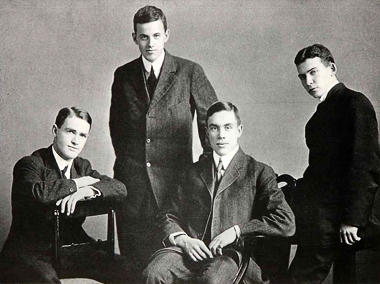
This university year has marked a series of important milestones for the Faculty of Law at McGill. In September, we celebrated the tenth anniversary of the integrated BCL/LLB ‘McGill Program,’ whose first cohort graduated ten years earlier. In October, we tipped our hats to the McGill Law Journal, whose first edition was published 60 years ago. And now, we mark an even more storied occasion, the centennial of the McGill Law Students’ Association.
 1912 — The First Law Undergraduate Society. Vice-President E. S. MacDougall; Secretary S.G. Dixon; President W. B. Scott; and Treasurer S. Lavery; (Old McGill 1913, page 88) |
Whatever happened to the original LSA Executive?LSA President W. B. Scott (BCL 1912) was wounded in WWI and lost a brother, Henry Hutton Scott (BCL 1914) in the fighting. Their father, Canon (later Archdeacon) F. G. Scott, was an army chaplain who served on the front lines until he was badly wounded in 1918. After the war, W.B. Scott became Associate Chief Justice of Quebec and saw his much-younger brother, F.R. Scott (BCL 1927), develop into the renowned law professor, poet and civil libertarian. E. S. MacDougall (BCL’13) was wounded at the Battle of Sanctuary Wood, where he helped other law colleagues evacuate, but saw many more perish. After the war, he would go on to become a founding partner of Wainwright, Elder and MacDougall and, later, a prominent Court of Appeals judge who served in Japan on the International Military Tribunal for the Far East. Slightly behind the others at university, S. G. Dixon (BCL 1914) was the inaugural Secretary of the student association and served as its VP the following year. He would also survive action in WWI, and would go on to become a rayon administrator at the War-Time Prices and Trade Board. He was awarded the Order of the British Empire in 1946. As for Salluste Lavery (BCL 1912), he served briefly in England, returning to father seven children and found a family firm. He became a controversial figure in the 1930s, as an active member of the Native Sons of Canada and defender of the notorious Adrien Arcand. |
McGill Law Professors of 1912-1913One hundred years ago, when the first LSA was founded, McGill law students could learn civil law from none other than Aimé Geoffrion, as well as notarial and civil law from William de Montmollin Marler, the law of evidence and the law of persons from Arnold Wainwright, and civil, commercial and public international law from the Honorable Charles Doherty, until his departure that year to become the Federal Minister of Justice. They also learned public international law from Eugène Lafleur, civil and municipal law from Archibald McGoun, and commercial law from the Hon. A.G. Cross, Gordon McDougall and many other top legal minds of the day. New faces at the Faculty in 1912 included a future Chief Justice of the Supreme Court, Thibaudeau Rinfret, as an instructor of municipal law and the law of public utilities, and a new civil law professor named Pierre-Basile Mignault, who would be eulogized 33 years later as “the living embodiment of civil law.” |
 2012 — The Centennial Law Students Association. Back row (L-R): Andrew Higdon, VP Clubs and Services; Graham Splawski, President; Andrew Baker, VP External; Paul Girard, VP Internal; Mike Mulroney, VP Finance. Front row: Sarah Kettani, VP Internal; Evita Ferreira, VP Administration; Alex Belley-McKinnon, VP Academic; Carole Gilbert, VP Public Relations. |
By Bridget Wayland
Just over one hundred years ago, a handful of McGill law students, led by William Bridges Scott (BCL 1912), founded the first Law Undergraduate Society, now known as the Law Students Association/l’Association des étudiants en droit. The original crew numbered only four, with Edward Stuart MacDougall (BCL 1913) as Vice-President, Salluste Lavery (BCL 1912) as Treasurer and Mr. Shirley Greenshields Dixon (BCL 1914) as Secretary (see photo on right).
The original law students’ association executive represented all 62 law students at McGill: There were 26 in first-year; only 18 in second and third. They wore academic dress (described as ‘a black silk gown falling below the knee, its hood lined with French grey silk’) at lectures, which were held on the top floor of what is now Dawson Hall, “the old but stately east wing of the Arts Building, commonly known as the Law Building,” as then-student H. E. Herschorn (BCL 1914) wrote in Old McGill.
At McGill one hundred years ago, law tuition was a mere $77 a session, plus a $10 fee for athletics, the Union and the Daily. Students would have attended brief lectures in the Law Building every morning and evening, spending the hours in between articling at law firms downtown. But they learned from some of the best, including the renowned Eugène Lafleur, who had just settled the Mexican-American boundary dispute in 1911. (See sidebar, right, for more examples of prominent profs of the day.)
A society in full expansion
Back in 1912, Montreal was in its pre-war heyday. It was by far the nation’s largest city, and home to the lion’s share of its wealth. Canada itself was booming, thanks to a heavy tide of immigration and full- speed-ahead development. Even its map grew exponentially in 1912, as tiny Manitoba pushed north to the 60th parallel, and Ontario and Quebec followed suit. It was a society in full expansion, and the law faculty was no exception.
The Dean of Law in 1912 was Frederick Parker Walton (LLD 1915), a forward-thinking Brit who was passionate about providing a broad-based legal education, as opposed to the narrow, professional training expected by the Bar at the time.
Dean Walton also lobbied for women’s rights in Quebec and saw Annie Macdonald Langstaff (BCL 1914) become the first woman to graduate from any Quebec law faculty, in the same class as inaugural LSA Secretary S.G. Dixon.
The Titanic and WWI
But all was not hunky dory for students of the first LSA. In 1912, the Faculty would have been rocked by news of the Titanic, which sank on April 15, taking with it the son of a prominent criminal law Professor and the next (interim) Dean, Sir Charles Peers Davidson (BA 1863, BCL 1864, MA 1867, DCL 1875, LLD 1912). Thornton Davidson had been travelling home with the Hays family—Thornton’s wife, Orian, and her mother and father, who was none other than Charles Hays, the President of the Grand Trunk Railroad—for the April opening of Hays’ Chateau Laurier, in Ottawa. Only the women survived.
For law students of a century ago, indeed for all Canadians of the day, the Titanic disaster did not spell the end of life as they knew it—but that would happen soon enough. On August 4, 1914, Britain declared war on Germany. Canadians signed up in droves, including 122 McGill law students and recent graduates. One of the first was W.B. Scott, the original LSA President, followed shortly by the Secretary, S.G. Dixon, and the Vice-President, E.S. MacDougall. All saw action overseas, including the June 1916 bloodbath known as the Battle of Sanctuary Wood, when most of the Faculty’s casualties took place. (See sidebar for more info.)
The LSA Today
One hundred years later, the current LSA President, Graham Splawski (BA’09, MA’10) (see 2012 LSA photo on right), wants to pay his respects to the past. With a master’s degree in history, Splawski takes a special interest in his Association’s centennial. “We looked through the LSA archives last summer,” he says, “and discovered hand-written minutes books and ledgers going back to 1943. We want to donate them to the McGill archives to keep them safe and get them properly catalogued.”
The McGill Law Students Association will celebrate their 100th anniversary with a special Valentine’s Day coffeehouse on February 14, 2013, to which all former members of the executive are invited. Visit https://www.facebook.com/groups/2263819331/#!/events/492652260773784/
For more on the original LSA and what life was like at the Faculty one hundred years ago, don’t miss our upcoming annual print magazine, Focus, due out at the end of the summer.
